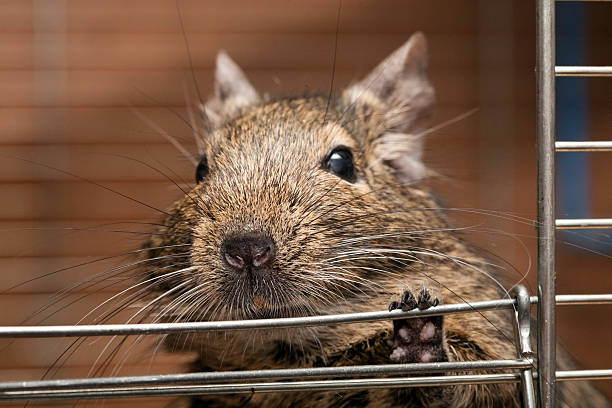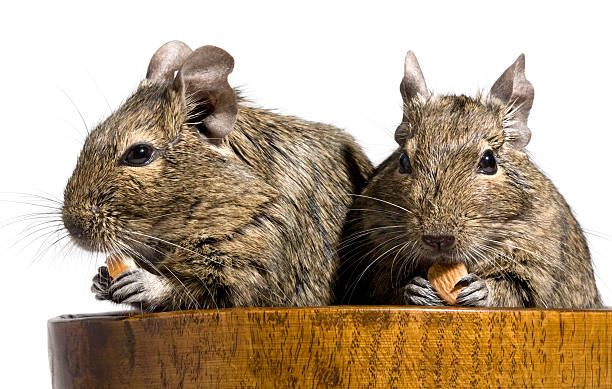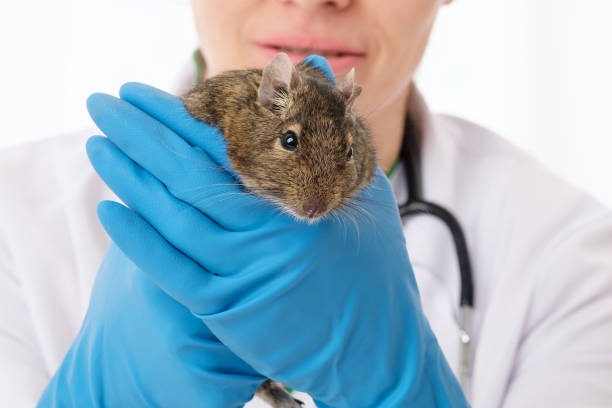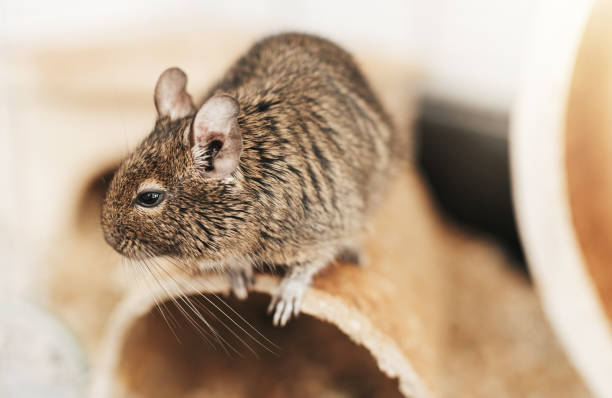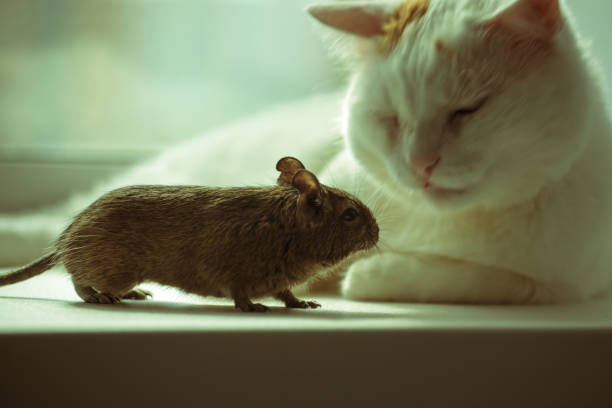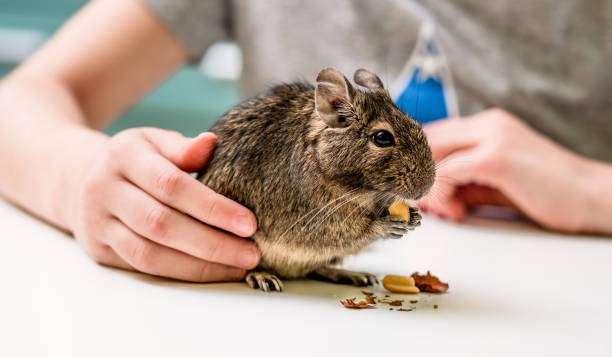Degu Travel Guide: Exploring the World with Your Furry Companions
This post contains affiliate links. This means I will make a commission at no extra cost to you should you click through and make a purchase. Read the full disclosure here.
Welcome to the exciting world of degu travel! If you’re the proud owner of these charming, sociable rodents, you probably know that including them in your adventures can be a rewarding and delightful experience. However, traveling with degus requires some special considerations to ensure their safety, comfort, and well-being throughout the journey.
In this blog post, we’ll guide you through the ins and outs of traveling with your beloved degus. Whether you’re planning a road trip, a vacation, or even just a visit to the veterinarian, knowing how to travel with your furry friends can make the experience not only stress-free but also enjoyable for both you and your degus.
Preparing for the Trip
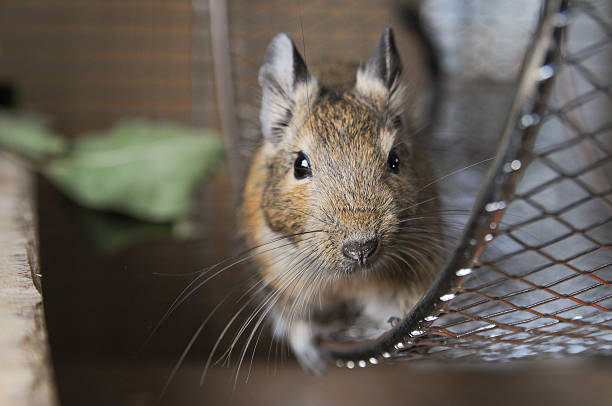
Before you hit the road or board a plane with your degus, careful preparation is key to a successful journey. Traveling with these small, delicate creatures requires attention to detail to ensure their comfort and safety throughout the trip. Here’s how to get started:
Planning Ahead
- Set a Travel Date: Choose a date that allows you ample time to plan and pack. Avoid traveling during extreme weather conditions, as degus are sensitive to temperature changes.
- Check Legal Requirements: Depending on your destination, there may be legal requirements for traveling with pets. Research any necessary permits, health certificates, or quarantine regulations well in advance.
Assemble a Travel Kit
- Degu Carrier: Invest in a secure and well-ventilated carrier designed for small animals. Ensure it has a secure latch and escape-proof features.
- Bedding and Nesting Materials: Line the carrier with familiar bedding material from your degus’ cage. This provides comfort and reassurance during travel.
- Water Bottle: Attach a spill-proof water bottle to the carrier, so your degus stay hydrated on the journey. Test it beforehand to ensure it works correctly.
- Travel Container for Food: Pack a container with a supply of your degus’ regular food. Measure out portions to avoid overfeeding during the trip.
- First Aid Kit: Include a basic first aid kit with essentials like sterile gauze, antiseptic wipes, and tweezers for emergencies.
- Identification Tags: Attach identification tags to the carrier with your contact information and any necessary travel permits.
Acclimating Your Degus
- Short Trips: If your degus aren’t accustomed to traveling, start with short trips around your home to help them get used to the carrier and the sounds and motions of travel.
- Positive Associations: Encourage positive associations by placing treats or familiar toys inside the carrier during practice trips.
Preparing Your Vehicle
- Secure the Carrier: When traveling by car, ensure the carrier is securely fastened and won’t shift during sudden stops or turns.
- Temperature Control: Maintain a comfortable temperature in the vehicle. Avoid extreme heat or cold, and use sunshades or window screens if necessary.
- Proper Ventilation: Ensure there’s adequate ventilation in the car. Never leave your degus in a closed vehicle on hot days.
With your travel kit ready and your degus gradually acclimated to their carrier, you’re well on your way to a safe and enjoyable journey. The next section will focus on creating a comfortable travel environment within the carrier for your precious companions.
Creating a Comfortable Travel Environment
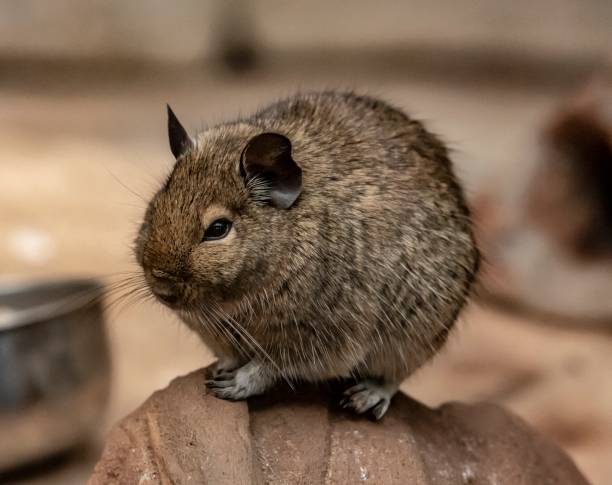
Ensuring your degus are comfortable throughout the journey is paramount. Since they’ll be spending a significant amount of time in their carrier, it’s essential to make this space as cozy and secure as possible. Here’s how to create a comfortable travel environment for your furry companions:
Bedding and Nesting Material
- Familiar Bedding: Line the carrier with bedding material from your degus’ home cage. This familiar scent will provide comfort and reassurance during travel.
- Nesting Material: Include nesting material like hay, shredded paper, or soft fabric for your degus to burrow and snuggle in. This helps reduce stress.
Ventilation and Temperature Control
- Proper Ventilation: Ensure there is ample airflow within the carrier. However, avoid direct drafts, as degus are sensitive to temperature changes.
- Temperature Control: Maintain a comfortable temperature inside the carrier. In hot weather, use cooling pads or ice packs (wrapped in a towel) to prevent overheating. In cold weather, provide extra bedding for insulation.
Securing Food and Water
- Steady Food Supply: Offer your degus access to their regular food during the journey. Use a spill-proof container to prevent messes.
- Hydration: Ensure the water bottle is securely attached to the carrier, allowing your degus to drink as needed.
Noise Reduction
- Minimize Noise: Travel can be noisy, which might stress your degus. Try to minimize loud sounds in the vicinity of the carrier and provide a quiet, calming atmosphere.
Familiar Objects
- Favorite Toys: Include a few of your degus’ favorite toys or items from their cage. Familiar objects can provide comfort and mental stimulation during travel.
Space and Companionship
- Space to Move: If you have multiple degus, ensure there’s enough space for them to move around comfortably. Consider using a larger carrier or dividing the space if necessary.
- Group Travel: Degus are social animals, and if they’re accustomed to living together, traveling as a group can reduce stress. Just be sure they have separate hiding spots if they need some personal space.
By focusing on these comfort factors within the carrier, you’ll help minimize stress for your degus during the journey.
Feeding and Hydration on the Go

Proper nutrition and hydration are vital to your degus’ well-being during travel. Maintaining their regular dietary routine while on the road will help ensure their health and comfort. Here’s how to handle feeding and hydration for your furry companions during the journey:
Preparing Travel Meals
- Portioned Meals: Measure out and pack the appropriate amount of your degus’ regular food in a sealed container. This ensures you don’t overfeed during the trip.
- Familiar Food: Stick to their usual food to avoid digestive upsets. Sudden dietary changes can lead to stomach problems.
Accessible Food Containers
- Travel Containers: Use secure, spill-proof containers for their food to prevent messes inside the carrier. These containers are designed to keep food fresh and dry.
- Easy Access: Ensure that your degus can reach their food easily. Place the food container in a location within the carrier where they can comfortably reach it.
Offering Hydration
- Water Bottle: Attach a spill-proof water bottle to the carrier. Make sure the spout is accessible to your degus. Test it before the trip to ensure it’s working correctly.
- Regular Water Changes: During breaks, check and refill the water bottle as needed to keep your degus well-hydrated.
Feeding Schedule
- Maintain Routine: Stick to your degus’ regular feeding schedule as closely as possible. This consistency helps them feel secure during travel.
- Avoid Overfeeding: While it’s essential to offer food, avoid overfeeding, as a full belly can lead to discomfort. Stick to their regular portion sizes.
Monitoring Eating Habits
- Observation: Keep an eye on your degus’ eating habits during the journey. Any sudden changes, like decreased appetite, should be noted and addressed.
Treats and Comfort Food
- Comfort Snacks: Pack a small supply of your degus’ favorite treats or comfort foods. These can be helpful for providing reassurance during travel.
Dealing with Motion Sickness

- Possible Nausea: Some degus may experience motion sickness. If this happens, offer smaller, more frequent meals to help reduce the risk of nausea.
By maintaining their regular feeding schedule and providing easy access to food and water, you’ll help ensure that your degus remain well-nourished and hydrated throughout the journey.
Safe Handling and Transportation
Ensuring the safety and well-being of your degus during travel involves proper handling and securing them in a suitable carrier. Here’s how to handle and transport your degus safely:
Transferring Your Degus
- Gentle Approach: Handle your degus gently and with care when transferring them into the carrier. Avoid sudden movements or grabbing.
- Use a Container: If your degus are skittish or unaccustomed to being held, you can place a smaller container or hideout inside the carrier. This allows them to move in and out at their own pace.
Securing the Carrier
- Proper Placement: In a car, secure the carrier in the back seat or cargo area, so it remains stable during the journey. Avoid placing it on the front seat or in your lap while driving.
- Seatbelt or Straps: Use a seatbelt or straps to secure the carrier in place. It should not shift during sudden stops or turns.
Minimizing Stress
- Cover the Carrier: Covering the carrier with a lightweight cloth or blanket can create a dark, calming environment for your degus. This can help reduce stress during travel.
- Avoid Loud Noises: Minimize loud music or other noisy distractions in the vehicle to maintain a tranquil atmosphere for your degus.
Frequent Monitoring
- Check-in: Periodically check on your degus during the journey. Ensure they are comfortable, have access to food and water, and are not showing signs of distress.
- Avoid Opening the Carrier: While checking on your degus is important, try to avoid opening the carrier while the vehicle is in motion. This can prevent escapes and accidents.
Rest Breaks
- Schedule Breaks: Plan for rest breaks during long journeys. These breaks provide opportunities for your degus to stretch, eat, and drink, as well as for you to check on their well-being.
- Secure the Carrier During Stops: If you take your degus out of the vehicle during breaks, ensure the carrier is secure and cannot be accessed by other animals or people.
By following these guidelines for safe handling and transportation, you’ll help ensure that your degus remain secure, calm, and comfortable during the journey.
Making Pit Stops

Pit stops are not only essential for you but also for your degus during a long journey. These breaks provide opportunities for your furry friends to stretch their legs, eat, drink, and relieve themselves. Here’s how to manage pit stops effectively when traveling with degus:
Schedule Regular Breaks
- Plan Ahead: Before you begin your trip, research and map out suitable places to make pit stops along your route. Aim for breaks every two to three hours.
- Time It Right: Plan your breaks to coincide with your degus’ natural activity patterns, which are typically more active during the day.
Degu Rest Area Setup
- Secure Enclosure: When you stop, set up a secure enclosure where your degus can safely roam outside of their carrier. Use a playpen or a designated area in your vehicle if it’s enclosed.
- Food and Water: Provide access to their food and water containers in the rest area. This allows them to eat and drink as needed.
- Hideouts and Toys: Include familiar hideouts and toys from their carrier to make the rest area feel comfortable and familiar.
Supervision
- Stay Nearby: While your degus are enjoying their break, stay close to monitor their activities and ensure their safety.
- Prevent Escapes: Be cautious when opening the carrier, and make sure all exits are secured to prevent escapes.
Restroom Breaks
- Provide a Litter Box: If your degus are accustomed to using a litter box, bring a portable one and place it in their rest area.
- Clean-Up: Clean up any waste promptly to keep the area clean and comfortable.
Exercise and Interaction

- Engage in Play: Interact with your degus during the break by offering playtime with their toys or gentle handling.
- Stretch Their Legs: Allow your degus to explore within the designated area. Make sure there are no hazards or potential escape routes.
Snacks and Treats

- Offer Treats: Provide small treats or comfort foods to reward your degus for good behavior during the break.
Limit Stressors
- Minimize Exposure: Avoid exposing your degus to extreme temperatures, direct sunlight, or loud noises during pit stops.
Remember that pit stops are essential for your degus’ well-being and comfort during the journey. By providing a safe and comfortable rest area with access to food, water, and entertainment, you’ll help reduce stress and make the travel experience more enjoyable for your furry companions.
Choosing Pet-Friendly Accommodations
If your journey involves overnight stays or longer breaks, selecting pet-friendly accommodations is crucial to ensure your degus have a safe and comfortable place to rest. Here’s how to find and prepare pet-friendly accommodations during your travels:
Research Pet-Friendly Options
- Plan Ahead: Before your trip, research and book accommodations that are known to be pet-friendly. Look for hotels, motels, or vacation rentals that explicitly welcome small animals like degus.
- Check Policies: Review the pet policies of your chosen accommodations to ensure they are suitable for your degus. Some may have specific rules or restrictions.
Room Setup
- Designate a Pet Area: In your accommodation, designate a specific area for your degus. This can be a quiet corner or a separate room.
- Degu-Proofing: Ensure the designated area is degu-proofed, removing any potential hazards or items they could chew on.
Cage or Enclosure
- Travel Cage: Set up a travel cage or carrier for your degus in their designated area. This should be a familiar and secure space for them.
- Bedding and Hideouts: Provide bedding, nesting materials, and familiar hideouts inside the travel cage for comfort.
Accommodation Amenities

- Check for Amenities: Some pet-friendly accommodations offer amenities like designated pet play areas or exercise spaces. Take advantage of these if available.
- Outdoor Exploration: If there’s a safe outdoor area, consider letting your degus explore in a secure, supervised manner.
Communication
- Notify the Staff: Inform the accommodation’s staff that you’ll be traveling with degus. They can provide guidance on the best setup and may be more accommodating if they know about your unique pet needs.
Supervision and Safety
- Supervise at All Times: While your degus are in the accommodation, supervise them closely to ensure their safety and prevent any potential escapes.
Cleaning and Tidying
- Clean-Up: Regularly clean the designated pet area, including any food spills or waste. Keeping the space clean is essential for both your degus’ comfort and the accommodation’s cleanliness.
Respect House Rules
- Follow Rules: Adhere to the accommodation’s pet rules and be respectful of other guests. Maintain a quiet and peaceful environment.
Choosing the right pet-friendly accommodations and setting up a comfortable space for your degus ensures that they have a safe and pleasant place to stay during your travels.
Health and Safety Considerations
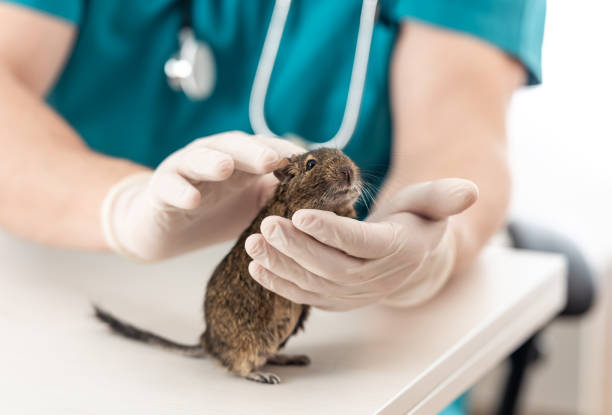
Traveling with your degus can be a rewarding experience, but it’s essential to prioritize their health and safety throughout the journey. Here are key health and safety considerations when traveling with degus:
Essential Medical Supplies
- First Aid Kit: Carry a basic first aid kit for your degus, including items like sterile gauze, antiseptic wipes, and tweezers. Be prepared for any minor injuries or health concerns.
- Medications: If your degus require medication, bring an adequate supply and administer it as prescribed by your veterinarian.
- Contact Information: Keep contact information for a local veterinarian along your travel route in case of emergencies. Research emergency veterinary clinics as well.
Monitoring Health
- Regular Check-Ins: During breaks, check on your degus’ overall health and behavior. Look for signs of stress or illness, such as decreased activity, lethargy, or changes in appetite.
- Record Keeping: Maintain a travel journal with notes on your degus’ behavior, eating habits, and any concerns. This information can be valuable if you need to seek veterinary care on the road.
Environmental Control
- Temperature: Ensure that the environment within the carrier or enclosure remains within a comfortable temperature range for your degus. Avoid exposing them to extreme heat or cold.
- Ventilation: Maintain proper ventilation to ensure an adequate supply of fresh air without drafts.
Handling with Care
- Gentle Handling: When you need to handle your degus, do so gently and with care to minimize stress. Be cautious of sudden movements.
- Escape Prevention: Always secure the carrier and enclosure to prevent escapes, especially in unfamiliar environments.
Emergency Plans
- Emergency Preparedness: Have a plan in case of unexpected events, such as a vehicle breakdown or severe weather. Ensure you have enough supplies to care for your degus in such situations.
- Evacuation Routes: Familiarize yourself with evacuation routes and pet-friendly shelters if you’re traveling to an area prone to natural disasters.
Stay Calm and Reassuring
- Calm Demeanor: Your degus can pick up on your emotions. Stay calm and reassuring to help reduce their stress levels.
- Comfort Items: Provide their favorite toys and comfort items to make them feel secure in unfamiliar surroundings.
Stay Informed
- Stay Updated: Keep abreast of any travel advisories, weather alerts, or road conditions that may affect your journey. Adjust your plans as needed for safety.
Prioritizing the health and safety of your degus at all times during travel is crucial. Being prepared and informed allows you to address any potential issues promptly and ensures a smooth and safe journey for your furry companions.
Managing Stress and Anxiety
Traveling, even with the best preparations, can be stressful for your degus. It’s important to actively manage their stress and anxiety to ensure their well-being during the journey. Here are some strategies to help keep your furry friends calm and comfortable:
Familiar Scents and Objects
- Bring Familiar Items: Pack a small bag with bedding, toys, and objects from your degus’ cage. These familiar scents and items can provide comfort and reassurance during travel.
- Use Their Travel Carrier: If your degus have been traveling in the same carrier during practice trips, this familiar environment can reduce stress.
Minimize Environmental Stressors
- Reduce Noise: Limit loud noises in the vehicle and avoid playing music at high volumes. Degus are sensitive to sound.
- Control Temperature: Maintain a comfortable temperature inside the vehicle to prevent overheating or getting too cold.
- Dim the Lights: Covering the carrier with a lightweight cloth can create a dark and calming atmosphere, reducing visual stressors.
Provide Comfort Stops
- Regular Breaks: Frequent pit stops not only allow your degus to stretch and eat but also provide a break from the constant motion of the vehicle.
- Quiet Rest Areas: Choose rest areas that are less crowded and have minimal noise, providing a quieter environment for your degus during breaks.
Stay Calm and Reassuring
- Calm Interaction: When you interact with your degus, maintain a calm and reassuring demeanor. Speak to them softly and offer gentle strokes if they enjoy it.
- Comfort Feeding: Offer treats or comfort foods to help ease their anxiety during the journey.
Keep a Routine
- Maintain a Schedule: Stick to your degus’ regular feeding and playtime schedule as closely as possible. Consistency can help them feel secure.
Monitor Behavior
- Watch for Signs: Keep an eye on your degus for any signs of distress, such as excessive grooming, pacing, or vocalizations. Address any issues promptly.
Positive Reinforcement
- Reward Calm Behavior: Praise and reward your degus for calm behavior during the trip. Positive reinforcement can help create positive associations with travel.
Avoid Unnecessary Handling
- Minimize Handling: While on the road, try to avoid unnecessary handling of your degus. Allow them to relax in their carrier.
Stay Informed
- Know the Route: Familiarize yourself with your travel route and the locations of veterinary clinics along the way. Having this information on hand can be reassuring.
By actively managing stress and anxiety and creating a comfortable, reassuring environment, you can help your degus stay calm and relaxed during travel.
Enjoying the Journey

While traveling with your degus requires careful planning and attention to their needs, it can also be an enriching and enjoyable experience for both you and your furry companions. Here are some tips for making the most of your journey together:
Bonding Time
- Quality Interaction: Use travel time as an opportunity to bond with your degus. Talk to them, offer gentle strokes, and engage in quiet play if they’re receptive.
- Capture Memories: Bring a camera or smartphone to capture memorable moments and snapshots of your degus during the journey.
Explore New Horizons
- Scenic Stops: Plan scenic routes or stops along your journey to enjoy new sights and experiences together.
- Pet-Friendly Attractions: Research pet-friendly attractions or parks you can visit along the way, allowing your degus to explore in a safe environment.
Create a Travel Journal
- Document Your Adventure: Keep a travel journal to record your experiences, your degus’ reactions, and any interesting encounters along the way.
- Share Your Story: Consider sharing your travel journal or blog with others who have or are considering traveling with their degus.
Traveling with Multiple Degus
- Companionship: If you have multiple degus, their companionship can provide comfort and entertainment for each other during the journey.
- Supervision: Ensure that interactions between your degus are peaceful and supervised to prevent any conflicts.
Take Breaks Together
- Shared Pit Stops: Whenever possible, include your degus in your breaks. Allow them to explore a secure area outside the carrier for a change of scenery.
Embrace Adventure
- Adventurous Spirit: Embrace the spirit of adventure and exploration. Your degus will pick up on your enthusiasm and may find the journey more exciting as a result.
Celebrate Milestones
- Special Milestones: If your journey includes significant milestones, such as reaching a destination or achieving a goal, celebrate with your degus with a small treat or extra playtime.
Reflect and Connect
- Quiet Moments: Take quiet moments during the journey to reflect on the unique experience of traveling with your degus and the bond you share.
- Connect with Fellow Travelers: If you encounter other pet owners on your journey, strike up conversations and share stories about your degus. You may make new friends along the way.
Stay Safe and Flexible
- Safety First: While enjoying the journey, always prioritize the safety and well-being of your degus. Be flexible with your plans to accommodate their needs.
Share Your Adventures
- Social Media: If you’re active on social media, consider sharing your travel adventures with your degus. Use relevant hashtags and connect with other pet enthusiasts.
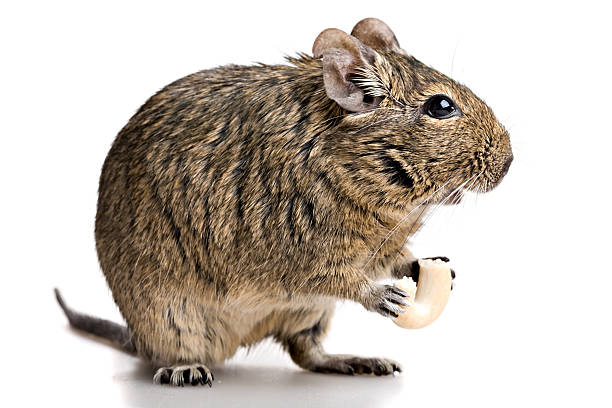
Traveling with your degus can be an enriching experience that strengthens your bond and creates lasting memories. By making the journey enjoyable for both you and your furry companions, you’ll create a positive travel experience for all. In the next section, we’ll summarize the key takeaways from this blog post and encourage readers to embark on their own journeys with confidence.



